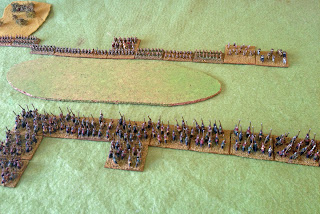5 x Blades (including the general)
4 x Warband
2 x Riders
1 x Shooter
The Romans defended and selected enough bad going to slow down the Arab cavalry.
This was how the armies set up - Arabs in the foreground, Romans beyond:
The Romans set up with their legionary infantry between the two patches of brush, and the brush swarming with auxilia. The cavalry were held in reserve until the main thrust of the Arab attack was determined.
The Arabs went for an attack on the Roman right using their camel-mounted warriors.
The Arab archers moved up to support the camels.
Battle was joined. The auxiliary infantry in the brush kept the Arabs pinned.
The Arabs were slowed, but not stopped, and attacked the Roman cavalry.
They lost one of their elements of archers to the Roman infantry, however.
The Roman cavalry was outflanked, and defeated.
The Roman commander pushed his centre forward looking to overwhelm the Arab infantry before the camels threatened his camp Stronghold.
The second Roman cavalry element was destroyed. The way to the Roman camp was clear.
There was lots of shoving back and forth in the centre.
However Roman discipline prevailed, and a group of Arab infantry was swept from the field.
Some Roman auxiliary infantry fell next, surrounded by Arabs and left nowhere to retreat.
The first camels arrived at the Stronghold, but not surprisingly they were repulsed.
More Arab infantry were routed. The Arabs were one element away from breaking now.
But another attack by the camels took the Stronghold, and the Romans were defeated.
The final battlefield. The Romans certainly had the upper hand, but lost their Stronghold. The problem was that once it was threatened they had nothing fast enough to rush back and defend it with. However their plan of an aggressive push forward, hoping to defeat the enemy army before the Stronghold fell was not a bad one.
Roman losses - one Warband and two Riders.
Arab losses: one Shooter and four Spears.
And it was great to have an army on the table and in play less than 36 hours after it was just a jumbled pile of basically unpainted figures in a box.





















































